Water, Sanitation, and Hygiene Laboratory Team
Team Lead: Jennifer Murphy, PhD
The lead laboratory unit for domestic and global water, sanitation, and hygiene (WASH)-related disease found in the natural environment in CDC's National Center for Emerging and Zoonotic Infectious Diseases.
Our Water, Sanitation, and Hygiene (WASH) Laboratory Team conducts:
- Diagnostics for free-living ameba infections
- Water-related outbreak investigations
- Molecular surveillance for Giardia and Cryptosporidium
- Water disinfection research
- Serologic assay development
Our WASH laboratory team also works with laboratories, subject matter experts, and programs around CDC.
Lab Units
Environmental Microbiology Laboratory
Principal Investigator: Jennifer Murphy, PhD
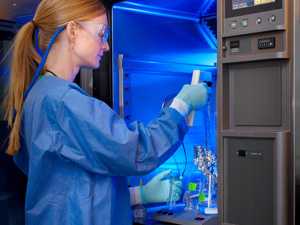
Water disinfection research
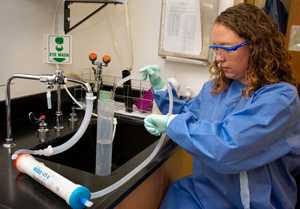
Water sampling using ultrafiltration
Mission: Developing and applying methods for environmental sampling, microbial detection, and treatment technologies to prevent WASH-related disease.
Our laboratory:
- Supports water-related emergency preparedness and outbreak investigations
- Conducts environmental sampling
- Water, wastewater, soil, sediment, biosolids, filters, and other environmental samples
- Completes environmental sample analyses
- Quantifies and/or detects viruses, bacteria, and parasites using culture, molecular, and microscopy methods
- Develops and tests new environmental sample detection methods
- Develops and improves disinfection and treatment methods for drinking water and recreational water
- Conducts environmental investigations to identify pathogens and indicators of fecal contamination
- Studies waterborne parasite biology & Cryptosporidium oocyst production
- Provides training on environmental sampling techniques and associated analytical methods
Environmental Microbiology Laboratory Highlights
Molecular Epidemiology Laboratory
Principal Investigator: Lihua Xiao, DVM, PhD
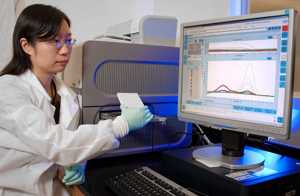
Molecular analysis of clinical and water samples
Mission: Developing and applying advanced molecular detection (AMD) methods for parasitic disease surveillance and outbreak investigations to prevent waterborne, foodborne, and zoonotic diseases.
Our laboratory:
- Investigates the molecular and genomic epidemiology of zoonotic parasites in humans and animals in the context of One Health
- Genotypes and subtypes waterborne and foodborne protozoan pathogens (Cryptosporidium, Giardia, Cyclospora, Microsporidia, Naegleria fowleri) in clinical and environmental samples
- Tracks sources and spread of protozoan parasites using advanced molecular detection tools
- Develops and manages CryptoNet–CDC's first molecular surveillance system for a parasite–a DNA sequence-based system for understanding U.S. transmission of cryptosporidiosis
Molecular Epidemiology Laboratory Highlights
Free-Living & Intestinal Amebas Laboratory (“Ameba Lab”)
Principal Investigator: Ibne Ali, PhD
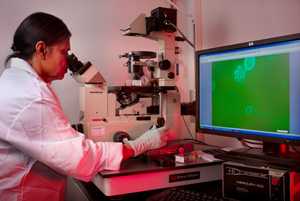
Specimen analysis for free-living amebas
Mission: Developing and applying diagnostic methods and drug therapies for opportunistic and pathogenic free-living and intestinal amebas to prevent future infections.
(A) For free-living amebas our laboratory:
- Diagnoses amebic infections, including pathogenic free-living Acanthamoeba spp., Balamuthia mandrillaris, Naegleria fowleri, and Sappinia using real-time PCR and immunofluorescence techniques
- Detects and identifies free-living amebas in environmental samples
- Develops and assesses drug therapies for free-living amebic infections
- Investigates genome sequences of free-living amebas
- Develops serologic methods for diagnosis of free-living amebic infections
-
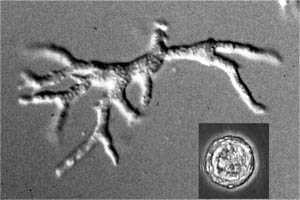
Balamuthia mandrillaris trophozoite and cyst
- Develops simple ELISA-based method for diagnosis of free-living amebas
- Investigates stage-specific proteome of free-living amebas
(B) For intestinal amebas our laboratory:
- Diagnoses amebic infections, including Entamoeba histolytica and Entamoeba dispar using real-time PCR
- Detects E. histolytica specific antibodies in serum samples using ELISA method
- Detects genotypes of infecting ameba using tRNA gene-linked typing method
- Develops novel genotyping and SNP-based methods for differentiation of clinical strains of E. histolytica
- Tests and assesses new drug therapies for intestinal amebic infections
- Investigates genomic differences that may account for differential outcome of infections using next generation sequencing techniques
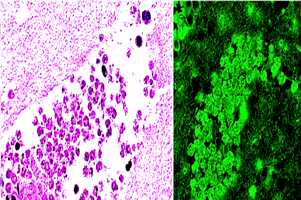
Naegleria fowleri in a brain section
Free-Living & Intestinal Amebas Laboratory Highlights
Serology Laboratory
Principal Investigator: Jeffrey Priest, PhD
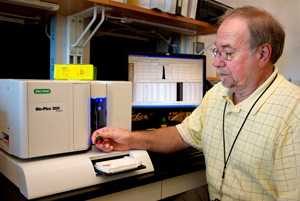
Multiplex bead serological assay
Mission: Developing multiplex serologic assays for use in surveillance and epidemiologic surveys to understand the spread of infectious disease.
Our laboratory:
- Identifies and expresses antigenic targets for new serological assays
- Develops Luminex bead-based serological assays for parasitic, viral, and bacterial infections
- Applies serological assays to surveillance and epidemiologic studies of pre- and post-public health intervention populations
- Conducts flow cytometry analysis and sample sorting to support scientific investigations
- Page last reviewed: October 23, 2014
- Page last updated: October 23, 2014
- Content source:


 ShareCompartir
ShareCompartir
